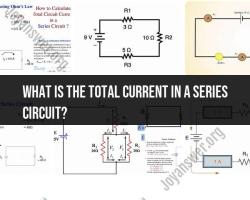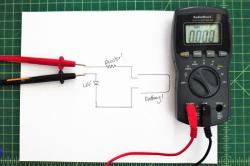What is the total current in a series circuit?
In a series circuit, the total current () remains the same throughout the entire circuit. This is a fundamental property of series circuits. Therefore, the total current in a series circuit is equal to the current passing through any single resistor or component within that circuit.
Mathematically, you can express this concept using Ohm's Law:
where:
- is the total current in amperes (A),
- is the total voltage across the circuit in volts (V),
- is the total resistance of the circuit in ohms (Ω).
The total resistance () in a series circuit is simply the sum of the individual resistances ():
Therefore, the formula for total current in a series circuit becomes:
In summary, the total current in a series circuit is determined by the total voltage across the circuit and the total resistance in that circuit. The total current is the same at any point in the series circuit.
How does resistance influence total current in a series circuit?
In a series circuit, resistance plays a crucial role in influencing the total current. It directly opposes the flow of current, acting like a barrier that hinders the movement of electrons. As the resistance increases, the current flowing through the circuit decreases. This relationship is governed by Ohm's Law:
I = V / R
- I: Current (measured in Amperes)
- V: Voltage (measured in Volts)
- R: Resistance (measured in Ohms)
Here's how resistance influences total current in a series circuit:
- Increased resistance: When the resistance in a series circuit increases, the flow of electrons faces greater opposition. This reduces the overall current flowing through the circuit. Imagine a water pipe with a valve. As you close the valve (increasing resistance), the water flow (current) decreases.
- Decreased resistance: Conversely, when the resistance in a series circuit decreases, the electrons encounter less opposition and can flow more readily. This results in an increase in the overall current flowing through the circuit. Think of opening the valve in the water pipe; more water flows (higher current) with less resistance.
Here are some additional points to consider:
- Series circuit property: In a series circuit, the same current flows through all components. This means that the increase or decrease in resistance at any point in the circuit affects the current flowing through the entire circuit.
- Impact on voltage: While resistance directly affects current, it also indirectly affects voltage. As resistance increases, the voltage drop across each component in the circuit increases, leading to a decrease in the overall voltage at the end of the circuit.
- Combined effect: The combined effect of voltage and resistance determines the total current in a series circuit. A change in one factor necessitates considering the impact on the other to accurately calculate the current.
Understanding how resistance influences total current is essential for various applications, including circuit design, troubleshooting electrical problems, and understanding the behavior of electronic components.




